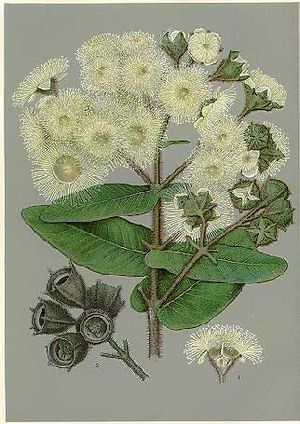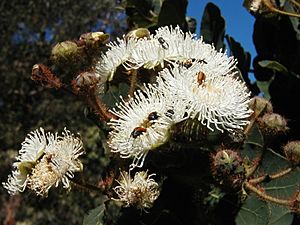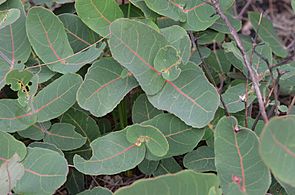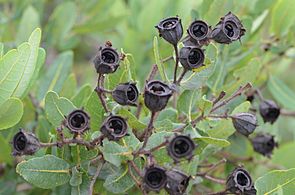Dwarf apple facts for kids
Quick facts for kids Dwarf apple |
|
|---|---|
 |
|
| Scientific classification | |
| Genus: |
Angophora
|
| Species: |
hispida
|
 |
|
| Occurrence data from AVH | |
| Synonyms | |
The Dwarf Apple (scientific name: Angophora hispida) is a small tree or a type of shrub called a mallee. It usually grows up to about 7 meters (25 feet) tall. It's called "dwarf apple" because it's much smaller than its relatives, like other Angophora and Eucalyptus trees. This plant is found only in a small area of central New South Wales, Australia. You can see it from just south of Sydney up to the Gosford region.
The Dwarf Apple has special leaves that don't have stalks; they sit right on the stem. Their bases are shaped like a heart. In fact, its old scientific name, A. cordifolia, meant "heart-leaved." Another cool thing about this plant is its red, bristly hairs. These hairs cover the small branches, flower bases, and new leaves. This is why its current scientific name is hispida, which means "bristly."
Contents
What the Dwarf Apple Looks Like
The Dwarf Apple grows as a small tree or a mallee shrub. It can reach about 7 meters (25 feet) in height. Its bark is greyish and tends to flake off.
Leaves and Stems
Like other plants in the Angophora group, its leaves grow in pairs directly opposite each other on the stem. This is different from most eucalypts. The leaves are oval-shaped and measure about 5–10 cm (2–4 inches) long and 3–4.5 cm (1.2–1.8 inches) wide. They have a rounded tip and a heart-shaped base. The top side of the leaves is a pale yellow-green, and the underside is greyish. When new leaves grow, they are covered in reddish hairs.
Flowers and Fruit
The Dwarf Apple blooms from November to January. Its flowers are creamy-white and quite showy. They grow in clusters at the ends of the branches. Each cluster has three to seven flowers. Just like the new leaves, the flower buds are also covered in reddish hairs. These buds are round with ridges and are about 0.9–1.3 cm (0.4–0.5 inches) wide.
After the flowers fall off, they leave behind woody, cup-shaped seed pods. These pods are about 1.5–2.6 cm (0.6–0.8 inches) long. They release their seeds in February and March. The seeds are flat, brown, and oval-shaped, measuring about 0.8–1 cm (0.3–0.4 inches) long.
Naming the Dwarf Apple
People call this plant by a few names, like "dwarf apple" and "scrub apple." The Cadigal people, who are Aboriginal Australians, call it banda.
Early Discoveries
The Dwarf Apple was first described by a scientist named James Edward Smith in 1797. He called it Metrosideros hispida. A surgeon from New South Wales, John White, had collected a sample of the plant in 1795. Another scientist, Antonio José Cavanilles, also described the plant in the same year. He called it Angophora cordifolia. This name was used for a long time, until 1976.
Modern Naming
In 1976, Don Blaxell found out that Smith's description had been published earlier in 1797. So, the name Angophora hispida became the correct one. Scientists continue to study how the Dwarf Apple is related to other plants. Some think it's closely related to the Smudgy Apple (Angophora woodsiana). Others believe it's closer to the Broad-leaved Apple (A. subvelutina).
Recent genetic studies show that Angophora plants are more closely related to Eucalyptus than to Corymbia. Because of this, some scientists have suggested that the Dwarf Apple could even be called Eucalyptus hispida one day. This plant can also mix with other Angophora species, creating new types of plants. For example, it can form hybrids with the Sydney Red Gum (Angophora costata) and A. bakeri.
Where the Dwarf Apple Lives
The Dwarf Apple is only found in the Sydney Basin area of Australia. It grows in dry, sandy soils that don't have many nutrients. You can find it in plant communities like heathlands, scrublands, or open woodlands.
Plant Neighbors
It often grows alongside other native plants. These include scribbly gums (Eucalyptus racemosa and E. haemastoma), red bloodwood (Corymbia gummifera), and narrow-leaved apple (Angophora bakeri). Other plants nearby might be heath banksia (Banksia ericifolia), rusty banksia (B. oblongifolia), and silver banksia (B. marginata). You might also see conesticks (Petrophile pulchella), scrub sheoak (Allocasuarina distyla), wax flower (Eriostemon australasius), and parrot pea (Dillwynia floribunda).
The Dwarf Apple grows from sea level up to about 300 meters (1000 feet) high. It thrives in areas that get about 800 to 1600 mm (30 to 60 inches) of rain each year.
Life Cycle and Ecology
The Dwarf Apple is very good at recovering after a bushfire. It can regrow from its woody base, called a lignotuber, or from special shoots on its trunk. It can even flower again within a year after being burned. This makes it an important food source for insects that eat nectar after a fire.
Attracting Wildlife
The flowers of the Dwarf Apple attract many different animals. Birds like the noisy miner and wattlebirds come to feed on the nectar. A wide variety of insects also visit, including honeybees, native bees, flies, moths, and butterflies. Many types of beetles are also drawn to the flowers. Some examples include the rose chafer (Eupoecila australasiae), green-velvet flower chafer (Glycyphana brunnipes), and the variable jewel beetle (Temognatha variabilis). Other visitors include the cowboy beetle (Chondropyga dorsalis), a scarab beetle called Bisallardiana gymnopleura, and members of the scarab genus Phyllotocus and soldier beetle genus Telephorus.
The Dwarf Apple is also a home for the young stages (larvae) of froghoppers, which are sometimes called spittlebugs. In addition, a type of mistletoe called Muellerina eucalyptoides can grow on the Dwarf Apple.
Growing Dwarf Apple in Gardens
The Dwarf Apple is a great choice for larger gardens. Its new growth is a lovely red color, and it produces many beautiful white flowers. These features make it a very attractive plant for people to grow. Since it flowers in summer, its blooms attract many brightly colored beetles, which can be fun to watch. To grow well, the Dwarf Apple needs a sunny spot and soil that drains water easily.
Gallery
See also
 In Spanish: Angophora hispida para niños
In Spanish: Angophora hispida para niños







